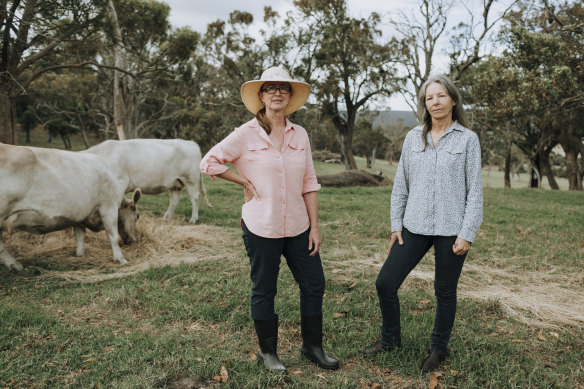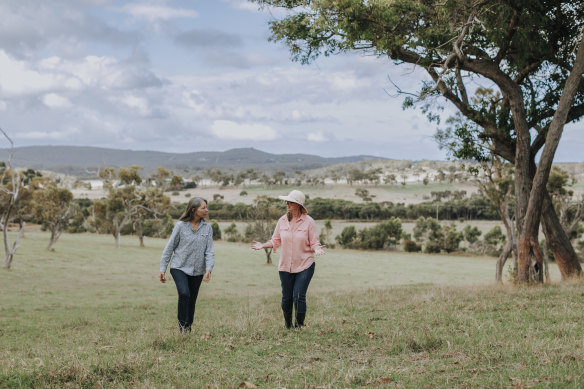When Pip Tilbrook left the hustle and bustle of Perth for 22 hectares of lush green paddock in the southernmost corner of the state, she never imagined she’d have to contend with prospectors eyeing her own backyard.
But that’s precisely what she and 200 of her neighbours in the Great Southern town of Torbay, 20 minutes out of Albany have spent the past 12 months doing after stumbling upon the plans of not one but two aspiring miners trying to secure exploration permits over their properties.

Wendy Coffey and Torbay resident Pip Tilbrook speak on Wendy’s 42-hectare Elleker property near Albany.Credit: Lee Griffith Photography.
About 300 kilometres north-west in Donnybrook dozens of community members are facing a similar predicament, where a mining tenement application is pending over 1100 square metres of farmland.
Prospectors have sought to snap up exploration and mining permits across more than 1 million hectares of farm land and native forest in the southern half of the state over the past six months alone.
WA is in the midst of a mining boom land grab, with the number of explorers staking claims jumping 8 per cent in the past year.
Much of it is being driven by the pursuit for battery minerals critical to the “green transition”, a move tipped to overturn the state’s perception of mining as something reserved for the red dirt of the noth-west.
Government bolsters critical minerals search effort
On Tuesday the state government announced a $40 million fund to bolster the search for critical minerals, almost half of which will be used to incentivise greenfield exploration.
Minerals found on private property belong to the Crown, and companies must apply to the Crown to explore for them.
If the minerals are believed to be close to the surface they must alert the landowner and mortgagee of the exploration plans, then strike a financial deal to compensate the landowner if exploration, and eventually mining, is to proceed.
But few know that if the mining company applies for a subsurface permit – to explore 30 metres below the surface – the law allows it to avoid advising the owner.
And landowners doing a deal aren’t required to inform their neighbours.
The only way for someone to know if a company has applied to do “subsurface” exploration is to proactively check a section of the mining department’s website for updates.

Pip Tilbrook and Wendy Coffey want more transparency in mining applications.Credit: Lee Griffith Photography.
The only way to object is to take it to the mining warden’s court, at their own expense, within 35 days of the permit application being lodged.
A growing number of South West residents believe some companies may be abusing the clause to avoid facing objections by unnecessarily claiming the materials would be more than 30 metres deep.
Their concerns have been exacerbated by a recent decision preventing public interest objections being heard in the court, one of vanishingly few avenues for residents to object to exploration in their neighbourhood.
The 100 objections lodged against the first bid to explore an area covering the properties of Pip Tilbrook and her neighbours in Torbay were enough to send the first mining hopeful packing.
But just a few months later, another permit bid was lodged in its place.
For Tilbrook the year-long battle has been a soul-destroying rollercoaster of emotions and with details of the miner’s intentions scant, she said it had been next to impossible to mount a legal argument or establish how the plan may affect her.
“It’s a war of attrition, there always seems to be more applications and more court dates,” she told WAtoday.
“I just can’t believe the onus is on us to find out about them [permit applications] and then fund the action against them.”
Melanie Stock, who lives about eight kilometres east of Tilbrook on her family’s 40-hectare property, was astonished the mining hopeful was under no obligation to inform them of the exploration proposal.
“What you see there is a presumption in favour of mining, rather than in favour of protecting water supplies and the community interest.”
Jess Beckerling, WA Forest Alliance
The pair believe there should be legislative change to force greater transparency.
With the matter set to return to the warden’s court in May, a spokesperson for applicant Mac Sand said the company was not in a position to comment.
Everything’s fine, government says
The agreement of one landholder did not give way to a sweeping exploration licence over the entire area sought, said the mining department’s resources tenure executive director Kristian Dawson.
He refuted that landholders were being left in the dark, highlighting all applications were publicly advertised by the regulator.
Dawson said the warden’s court was the right place to deliberate permits and that it was standard practice for the costs to be borne by the parties involved.
Mining Minister Bill Johnston also defended the system, stressing the state had the mechanisms necessary to strike the proper balance between the interests of landowners, industry and environment.
He highlighted that an exploration permit entitled the holder to just that and that no productive mining could occur without approval.
But the response wasn’t enough to allay the concerns of Dr Jeff Bremer, who has been investigating what he has dubbed a loophole in the act and rallying on behalf of landowners in the warden’s court.
He has since formed Save Preston Valley in a bid to safeguard the area from mining and lobby for change to the mining act, bringing the issue to public attention and calling on local governments to take a stand.
“The minister’s response is out of touch,” he said.
“The minister’s office should stop justifying unfair practices in the [mining] industry and spend more time listening to constituents and the distressed communities.”
Bremer became involved after stumbling upon exploration permits pending over swathes of the northern jarrah forest, an issue of particular concern to the WA Forest Alliance.
WAFA campaign director Jess Beckerling said about a quarter of the forest was under new exploration permit applications, with bauxite miner Alcoa pushing ahead with a major expansion of its 60-year-old operations and Rio Tinto and billionaire prospector Mark Creasy’s Telupac between them eyeing 240,000 hectares.
While conceding the world would need new technologies to decarbonise, Beckerling said there was no climate solution to be found in the clearing of native forests or depletion of critical water sources, pointing out the forest had already lost 90 per cent of its natural vegetation in the past 200 years.
She said the warden’s court had traditionally served as the forum for public interest matters to be considered, other than appealing directly to the Minister, and that restricting public interest objections was of great concern.
“There’s already such limited scope for the community’s views and the public interest to be taken into account before permits are issued, leases are approved and mining begins,” she said.
“What you see there is a presumption in favour of mining, rather than in favour of protecting water supplies and the community interest.”
A spokesperson for Rio Tinto told WAtoday any exploration would be undertaken in accordance with the company’s commitment to sound environmental management and stewardship.
Residents take on a mining billionaire – and lose
Residents affected by permits close to their homes fear their fate was sealed in December, when a company controlled by prolific WA prospector Mark Creasy secured a gag order preventing objectors to exploration in the Jarrahdale Forest from being heard in the approval of its permit.
The battle began 18 months ago when Creasy’s company Telupac sought an exploration licence covering a 12-kilometre stretch of forest between Jarrahdale and Keysbrook and Serpentine Falls.
The Jarrahdale Forest Protectors lobby group demanded to present evidence about the plan’s environmental, social and economic impacts.
But Telupac asked that the complaints be thrown out, casting doubt over the credibility of the objectors’ evidence and insisting the concerns raised would be addressed through the rigorous processes of government agencies.
While acknowledging the need for scrutiny, Warden Genevieve Cleary said her decision-making powers were limited to those in the act, and it was not for her to weigh up competing policy considerations and hear evidence that would be reviewed by expert agencies later.
“It is self-evident that where there is national park, nature reserves, designations of endangered and vulnerable communities and water reserves and catchments, mining will have an impact,” she said.
“The proposed conditions and endorsements illustrate that there are a significant number of agencies, enactments and mechanisms in place to ensure vigorous scrutiny of the application.”
Jarrahdale Forest Protectors spokesperson Jan Starr told WAtoday the group was disappointed by the decision.
Creasy Group was contacted for comment.
The Morning Edition newsletter is our guide to the day’s most important and interesting stories, analysis and insights. Sign up here.